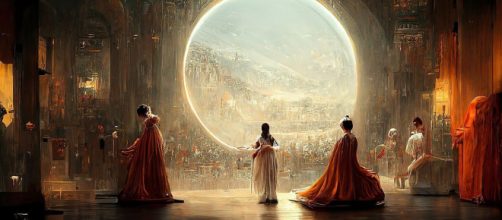Is machine-made art "art"? Are you cheating if you use artificial intelligence to make a painting for a competition?
Last week, Jason Allen's entry titled "Space Opera Theater," picturing three figures arrayed in flowing robes, won First Place in the Colorado State Fair's fine arts competition. But Allen, known for creating video games, didn't exactly produce the picture. An image synthesizer called Midjourney did that.
Of course, one might not have any cause for concern. After all, a new technique in artmaking is the story of art history when artists routinely push back against tradition.
Historic tells the story
The Impressionists, for example, dissatisfied with academic techniques and classical themes, got out of their studios to capture the light of day and everyday life. Their innovations, now collected by museums worldwide, were once considered a radical departure from what was.
As well, the Renaissance was a revolt against the stiff doctrine-dictated imagery of the Middle Ages. Fifteen-century artists wanted to show the beauty of the human form and portray people as people rather than divine beings.
Then, in the 16th century, the Mannerists railed against the Renaissance canons. They wanted their art to stand for people's struggles, the human condition.
In the next century, Baroque artists piled on the emotion using the Mannerists' strains, using stagy lighting for greater theatrical effect.
And that's what Allen's prize-winning picture looks like – theatrical. But unlike the Baroque painters, who made their imagery by hand, Allen's picture only looks like a painting. An online program spits out what you see - a photo-real image of a stage production – in 60 seconds.
Allen's input amounted to typing in words like "opulent," "lavish" "woman in frilly Victorian dress," and "epic scenes like out of a dream" into a text-to-image tool (Midjourney) that comes with billions of internet images and presto, "Space Opera Theater." Art on demand.
Wait, Allen had one more task required by Midjourney: to name the style for the picture. He asked for "Leonardo da Vinci's style."
Look Ma, no hands
All that was left for him to do was make a few adjustments in Adobe Photoshop and print.
No sweat.
As if self-conscious about how little skill went into his image, he told the Washington Post, "If there's one thing you can take ownership of, it's your prompt" – what you tell the machine to do." So, there's that.
It goes without saying that art lovers are not happy about this. Allen's triumph in the art contest sparked a bonfire of online complaints. "We're watching the death of artistry unfold right before our eyes," said one Tweet.
The Washington Post quotes Allen, again defending himself, saying that Midjourney "is a tool. Just like the paintbrush is a tool. Without the person, there is no creative force."
Indian Express reported how critics objected to the very idea of a text-to-image tool, likening it to "painting-by-numbers."
But the thing is, with a painting by numbers, you actually paint.
There's no painting going on with the Midjourney tool. And that's my main complaint: a picture that looks like a painting but skips the step that makes a picture worth collecting - the artist's own hand.


